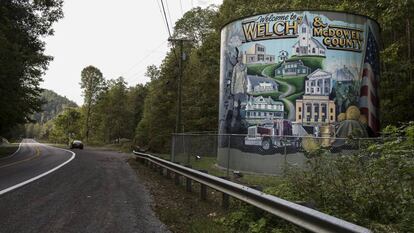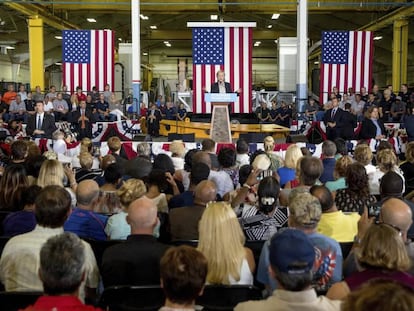The long, slow, death of white, working-class America
The appeal of the Trump phenomenon, explained from the epicenter of poverty in the United States

McDowell County funeral parlors have gotten used to seeing younger cadavers arrive at their doors. Jim Sly, who is in charge of Fanning Funeral Home in Welch, the county seat, remembers when two people who had come to make funeral arrangements for a deceased relative passed out at the parlor. He suspects that they were under the influence of some kind of narcotics.

“We see more deaths due to overdose than before,” Sly says. “Though maybe,” he adds, “we are better now at diagnosing them.”
It is difficult to find someone in this mining region in the Appalachians who does not have a family member or friend with a drug problem, especially when it comes to painkillers, which they can get with a medical prescription.
It’s hard to find someone in this mining region who doesn’t have a family member or friend with a drug problem
No freeways connect this county to the outside world. There are no supermarkets stocked with fresh fruits or vegetables, and no opportunities to earn a living unless it’s thanks to government subsidies. The most isolated region in the country, the whitest and most rural of the United States, is slowly dying – and not just because of an overdose.
“I have a funeral tomorrow,” says Martin West, the county sheriff. “A young man with some problems.” There are two boxes at the entrance of the office that invites visitors to deposit pills and syringes anonymously for disposal.
Besides serving as sheriff, West is a Protestant pastor. As an agent of peace, his mission is to chase down crime: nine out of 10 cases he works on involve drugs. As a preacher, he must console the families destroyed by an epidemic that has contributed to a sharp rise in mortality among whites aged 45 to 54. Life expectancy for men in McDowell was 64 years in 2010, 18 years fewer than their counterparts in Fairfax County, a suburb of Washington, D.C., that sits 560 kilometers away.
The county was once home to 100,000 residents, years when coal was to Welch what the car is to Detroit
Shop windows in Welch and in other nearby towns along US Route 52 are boarded up. An abandoned school with a music room, a piano and its last score. A hotel in ruins. Houses whose interiors are overgrown with vegetation. These are the remains of a glorious past, when the county was home to 100,000 residents, years when coal was to Welch what the car is to Detroit.
Today, 18,000 people live in McDowell. There are no dealerships and, since Wal-Mart closed last winter, there are no big stores either. Wal-Mart, with its low prices and endless sales, is blamed for destroying the fabric of small shops and urban centers throughout rural America. Yet, paradoxically, when Wal-Mart closed its doors, it dealt a second blow, perhaps the hardest, to McDowell County. Now, residents have to travel more than an hour over sinuous highways to nearby counties to shop.
“Store closed at 7pm. Thursday January 27, 2016,” says a note taped to the door of the boarded-up Wal-Mart center. It reads like a death certificate.
Paradoxically, when Wal-Mart closed its doors, it dealt perhaps the hardest blow to McDowell County
“It was the center of social life in the county,” says Linda McKinney. She and her husband, Bob, manage a food and clothing bank that helps 1,200 to 1,800 people – 10% percent of McDowell residents – every month. Wal-Mart’s departure also affected the bank; the giant store donated left-over food.
One-third of McDowell residents lives in poverty, according to the US Census Bureau. Annual incomes per capita reach $14,813 (€13,300), half of what the rest of the nation makes. McKinney attributes the high mortality rate to a lack of exercise and poor nutrition because the area lacks supermarkets that could provide fresh foods.
“We are not different from other parts of the world, except for one fact: we do not have a middle class,” says Harold McBride, McDowell County president. As people migrate to other counties, McBride says, they take away the social glue needed for this community to recover.
Republican candidate Donald Trump does not excite this Democratic county but no one here can forget that Hillary Clinton took for granted the fact that many coal miners would lose their jobs, in a statement Appalachian residents interpreted as a declaration of war against them.
In the reception hall of Widener Funeral Home, a headline from The Welch News reads: “Carfentanil: A New Factor in the US Opioid Crisis.” Kenneth Widener, who works in the family business, says the number of deaths due to overdose is still a small fraction of the total. But “when we show up in the news,” he explains, “they always show the worst home and the worst-looking person.”
Driving through back roads among idyllic landscapes, Sabrina Shrader, a tireless fighter for the good name of this land, recalls her childhood in McDowell, where she lived until she was 13 years old. She participated in the campaign launched by Bernie Sanders, Clinton’s rival in the Democratic primaries, and she is running for a West Virginia Legislature seat for Mercer County. “I am an Appalachian Christian,” says Shrader, who shows pride in her identity and peppers her sentences with Bible references.
Davy, a town of 400 residents located next to a railroad line, is home to the Wingates: Adam, his wife Heather, and their two children. Adam Wingate immigrated to the United States from Lebanon when he was five years old. A local family adopted him. Wingate is a miner and he has been out of work for four months.
“There is no way I want my kids to stay here,” he says. He has found needles in the park nearby.
Heather Wingate remembers the car accident she had when she was 22 years old. The doctor prescribed 180 painkillers. “Here,” she says, “good people do bad things.”
English version by Dyane Jean François.
The “invisible audience”
According to economists Anne Case and Angus Deaton, the rise in mortality among middle-aged whites is not happening in any other developed country or among other ethnic groups in the United States.
These men and women fill the ranks of Donald Trump supporters. His populist nationalist message has helped the Republican candidate connect with voters who feel displaced by globalization, scorned by elites, and put at a disadvantage in a country that is growing increasingly more diverse.
As Anne Case wrote, they are “an audience that feels increasingly invisible.”
McDowell County, West Virginia is the county with the third-highest rate of premature death in the United States, according to “County Health Rankings” from the University of Wisconsin Population Health Institute, a study that measures where residents are most likely to die before the age of 75.
The other two counties with the highest mortality rates are on Indian reservations in South Dakota.
Tu suscripción se está usando en otro dispositivo
¿Quieres añadir otro usuario a tu suscripción?
Si continúas leyendo en este dispositivo, no se podrá leer en el otro.
FlechaTu suscripción se está usando en otro dispositivo y solo puedes acceder a EL PAÍS desde un dispositivo a la vez.
Si quieres compartir tu cuenta, cambia tu suscripción a la modalidad Premium, así podrás añadir otro usuario. Cada uno accederá con su propia cuenta de email, lo que os permitirá personalizar vuestra experiencia en EL PAÍS.
¿Tienes una suscripción de empresa? Accede aquí para contratar más cuentas.
En el caso de no saber quién está usando tu cuenta, te recomendamos cambiar tu contraseña aquí.
Si decides continuar compartiendo tu cuenta, este mensaje se mostrará en tu dispositivo y en el de la otra persona que está usando tu cuenta de forma indefinida, afectando a tu experiencia de lectura. Puedes consultar aquí los términos y condiciones de la suscripción digital.











































